Entrepreneurs and Islamic Microfinance in Sylhet, Bangladesh
VerifiedAdded on 2022/12/29
|13
|3966
|69
Report
AI Summary
This report delves into the motivations, experiences, and challenges encountered by entrepreneurs in the Sylhet Region of Bangladesh when seeking Islamic Microfinance support. The research aims to identify the driving forces behind entrepreneurs' preference for Islamic Microfinance over conventional banking schemes, particularly focusing on the ethical considerations and Shariah compliance. The study explores the key challenges, such as funding constraints, accounting deficiencies, lack of collateral, and operational inefficiencies, faced by entrepreneurs. Furthermore, the report examines the potential contributions of Islamic Microfinance schemes towards sustainable development and poverty alleviation in the region, considering factors like Murabahah and its impact on the Islamic financial sector. The methodology involves a qualitative approach utilizing an interpretivism research philosophy and an inductive research approach, with data collected through primary and secondary methods, including interviews, to provide a comprehensive analysis of the subject.
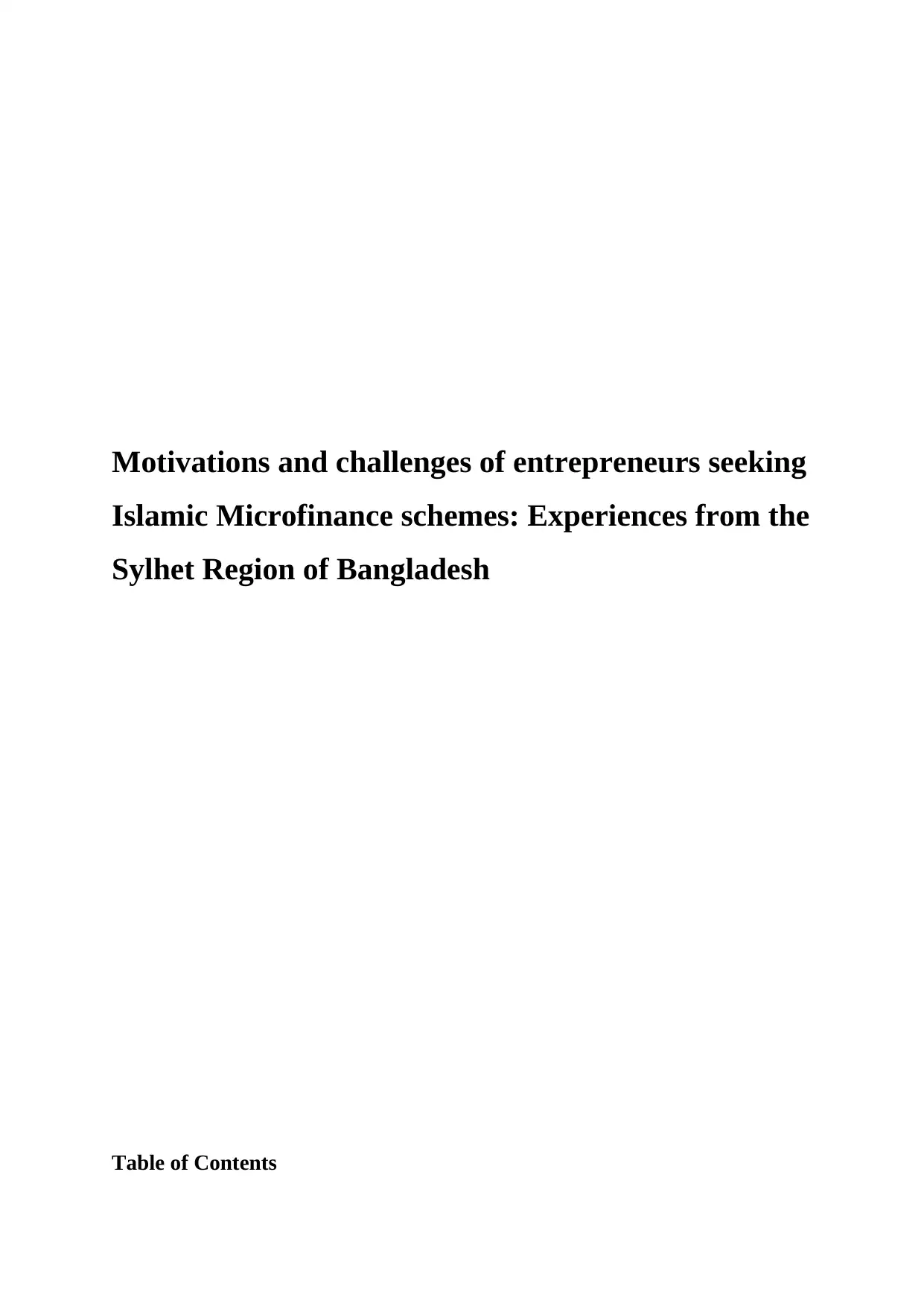
Motivations and challenges of entrepreneurs seeking
Islamic Microfinance schemes: Experiences from the
Sylhet Region of Bangladesh
Table of Contents
Islamic Microfinance schemes: Experiences from the
Sylhet Region of Bangladesh
Table of Contents
Paraphrase This Document
Need a fresh take? Get an instant paraphrase of this document with our AI Paraphraser
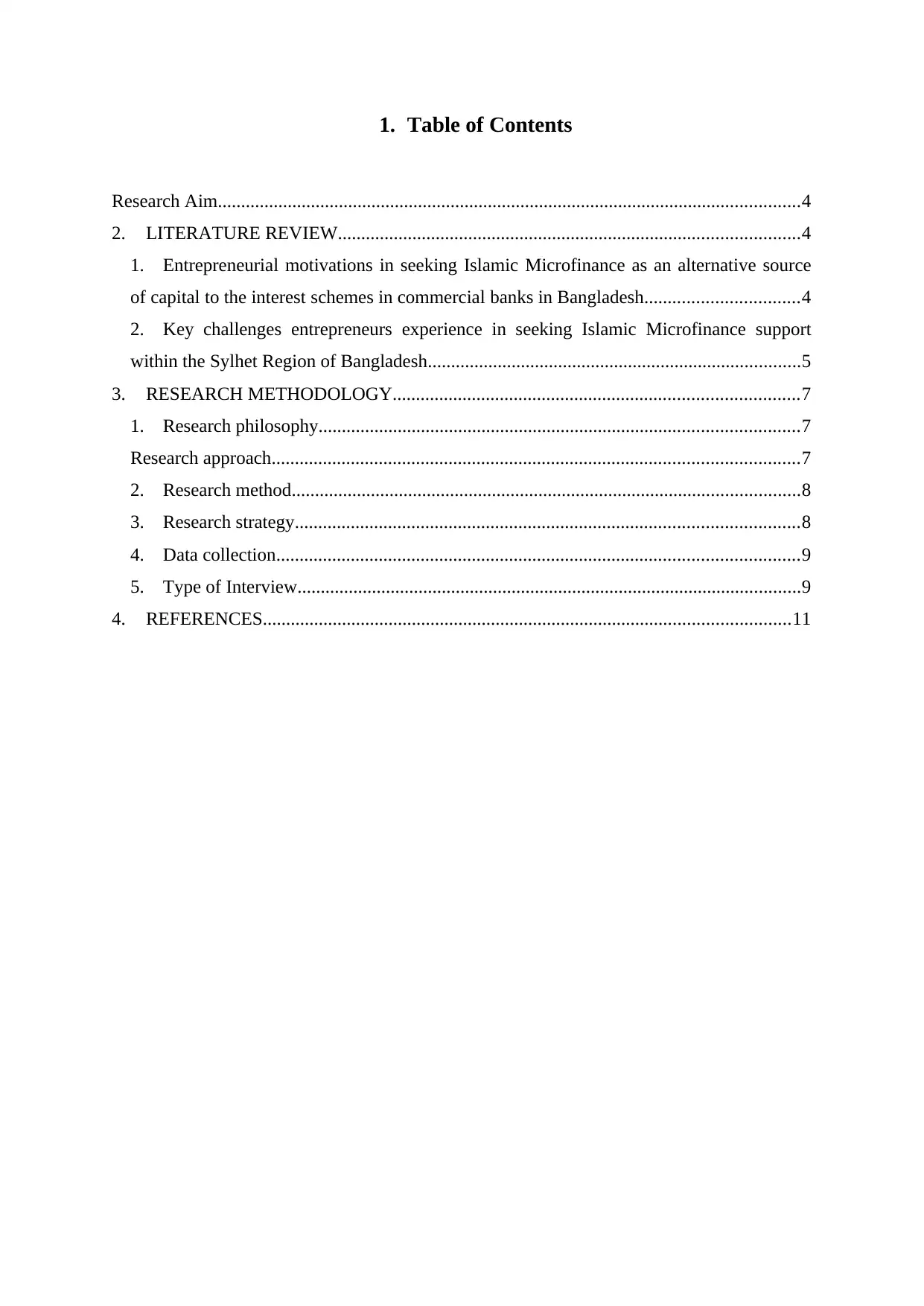
1. Table of Contents
Research Aim.............................................................................................................................4
2. LITERATURE REVIEW...................................................................................................4
1. Entrepreneurial motivations in seeking Islamic Microfinance as an alternative source
of capital to the interest schemes in commercial banks in Bangladesh.................................4
2. Key challenges entrepreneurs experience in seeking Islamic Microfinance support
within the Sylhet Region of Bangladesh................................................................................5
3. RESEARCH METHODOLOGY.......................................................................................7
1. Research philosophy.......................................................................................................7
Research approach.................................................................................................................7
2. Research method.............................................................................................................8
3. Research strategy............................................................................................................8
4. Data collection................................................................................................................9
5. Type of Interview............................................................................................................9
4. REFERENCES.................................................................................................................11
Research Aim.............................................................................................................................4
2. LITERATURE REVIEW...................................................................................................4
1. Entrepreneurial motivations in seeking Islamic Microfinance as an alternative source
of capital to the interest schemes in commercial banks in Bangladesh.................................4
2. Key challenges entrepreneurs experience in seeking Islamic Microfinance support
within the Sylhet Region of Bangladesh................................................................................5
3. RESEARCH METHODOLOGY.......................................................................................7
1. Research philosophy.......................................................................................................7
Research approach.................................................................................................................7
2. Research method.............................................................................................................8
3. Research strategy............................................................................................................8
4. Data collection................................................................................................................9
5. Type of Interview............................................................................................................9
4. REFERENCES.................................................................................................................11
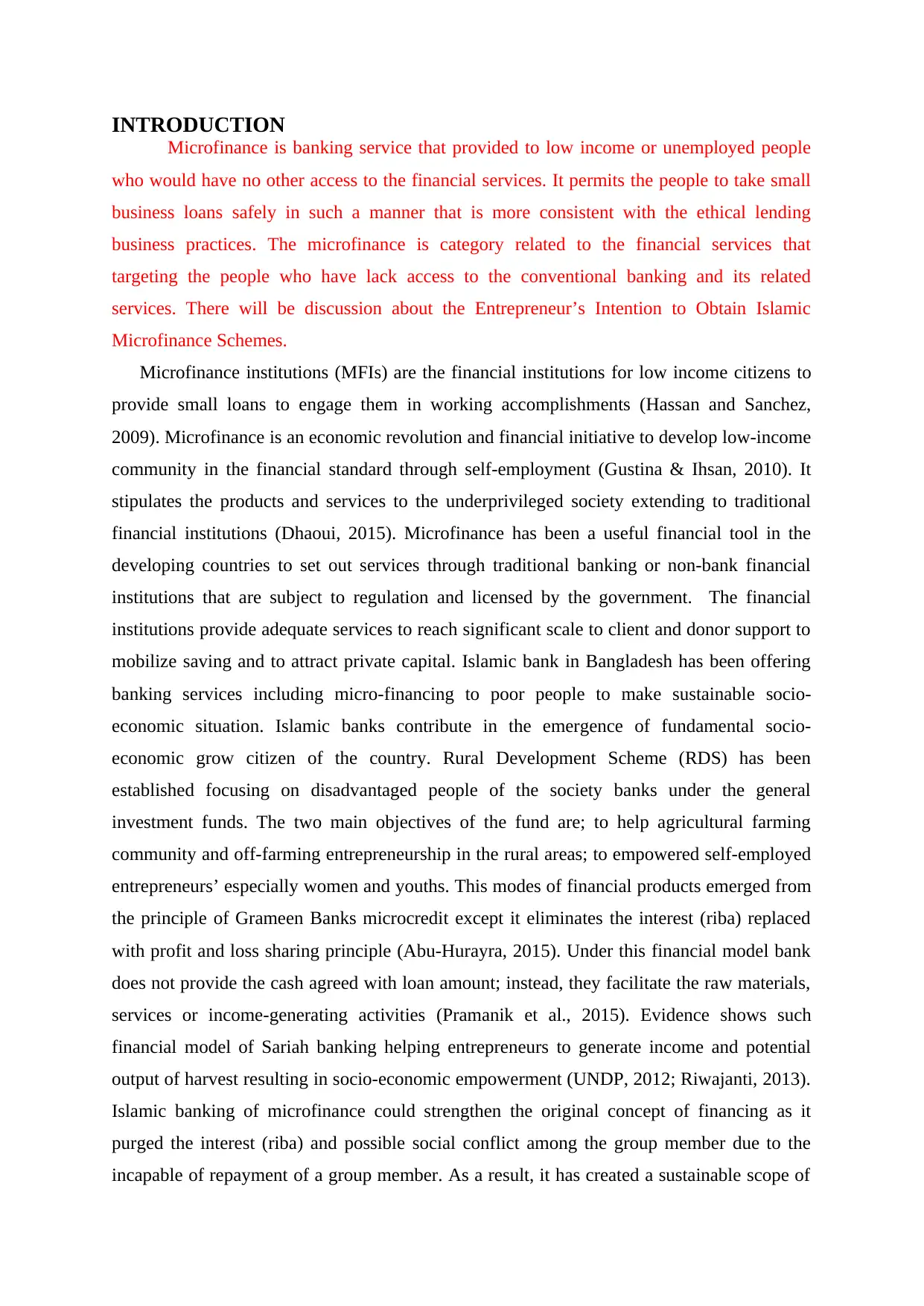
INTRODUCTION
Microfinance is banking service that provided to low income or unemployed people
who would have no other access to the financial services. It permits the people to take small
business loans safely in such a manner that is more consistent with the ethical lending
business practices. The microfinance is category related to the financial services that
targeting the people who have lack access to the conventional banking and its related
services. There will be discussion about the Entrepreneur’s Intention to Obtain Islamic
Microfinance Schemes.
Microfinance institutions (MFIs) are the financial institutions for low income citizens to
provide small loans to engage them in working accomplishments (Hassan and Sanchez,
2009). Microfinance is an economic revolution and financial initiative to develop low-income
community in the financial standard through self-employment (Gustina & Ihsan, 2010). It
stipulates the products and services to the underprivileged society extending to traditional
financial institutions (Dhaoui, 2015). Microfinance has been a useful financial tool in the
developing countries to set out services through traditional banking or non-bank financial
institutions that are subject to regulation and licensed by the government. The financial
institutions provide adequate services to reach significant scale to client and donor support to
mobilize saving and to attract private capital. Islamic bank in Bangladesh has been offering
banking services including micro-financing to poor people to make sustainable socio-
economic situation. Islamic banks contribute in the emergence of fundamental socio-
economic grow citizen of the country. Rural Development Scheme (RDS) has been
established focusing on disadvantaged people of the society banks under the general
investment funds. The two main objectives of the fund are; to help agricultural farming
community and off-farming entrepreneurship in the rural areas; to empowered self-employed
entrepreneurs’ especially women and youths. This modes of financial products emerged from
the principle of Grameen Banks microcredit except it eliminates the interest (riba) replaced
with profit and loss sharing principle (Abu-Hurayra, 2015). Under this financial model bank
does not provide the cash agreed with loan amount; instead, they facilitate the raw materials,
services or income-generating activities (Pramanik et al., 2015). Evidence shows such
financial model of Sariah banking helping entrepreneurs to generate income and potential
output of harvest resulting in socio-economic empowerment (UNDP, 2012; Riwajanti, 2013).
Islamic banking of microfinance could strengthen the original concept of financing as it
purged the interest (riba) and possible social conflict among the group member due to the
incapable of repayment of a group member. As a result, it has created a sustainable scope of
Microfinance is banking service that provided to low income or unemployed people
who would have no other access to the financial services. It permits the people to take small
business loans safely in such a manner that is more consistent with the ethical lending
business practices. The microfinance is category related to the financial services that
targeting the people who have lack access to the conventional banking and its related
services. There will be discussion about the Entrepreneur’s Intention to Obtain Islamic
Microfinance Schemes.
Microfinance institutions (MFIs) are the financial institutions for low income citizens to
provide small loans to engage them in working accomplishments (Hassan and Sanchez,
2009). Microfinance is an economic revolution and financial initiative to develop low-income
community in the financial standard through self-employment (Gustina & Ihsan, 2010). It
stipulates the products and services to the underprivileged society extending to traditional
financial institutions (Dhaoui, 2015). Microfinance has been a useful financial tool in the
developing countries to set out services through traditional banking or non-bank financial
institutions that are subject to regulation and licensed by the government. The financial
institutions provide adequate services to reach significant scale to client and donor support to
mobilize saving and to attract private capital. Islamic bank in Bangladesh has been offering
banking services including micro-financing to poor people to make sustainable socio-
economic situation. Islamic banks contribute in the emergence of fundamental socio-
economic grow citizen of the country. Rural Development Scheme (RDS) has been
established focusing on disadvantaged people of the society banks under the general
investment funds. The two main objectives of the fund are; to help agricultural farming
community and off-farming entrepreneurship in the rural areas; to empowered self-employed
entrepreneurs’ especially women and youths. This modes of financial products emerged from
the principle of Grameen Banks microcredit except it eliminates the interest (riba) replaced
with profit and loss sharing principle (Abu-Hurayra, 2015). Under this financial model bank
does not provide the cash agreed with loan amount; instead, they facilitate the raw materials,
services or income-generating activities (Pramanik et al., 2015). Evidence shows such
financial model of Sariah banking helping entrepreneurs to generate income and potential
output of harvest resulting in socio-economic empowerment (UNDP, 2012; Riwajanti, 2013).
Islamic banking of microfinance could strengthen the original concept of financing as it
purged the interest (riba) and possible social conflict among the group member due to the
incapable of repayment of a group member. As a result, it has created a sustainable scope of
⊘ This is a preview!⊘
Do you want full access?
Subscribe today to unlock all pages.

Trusted by 1+ million students worldwide
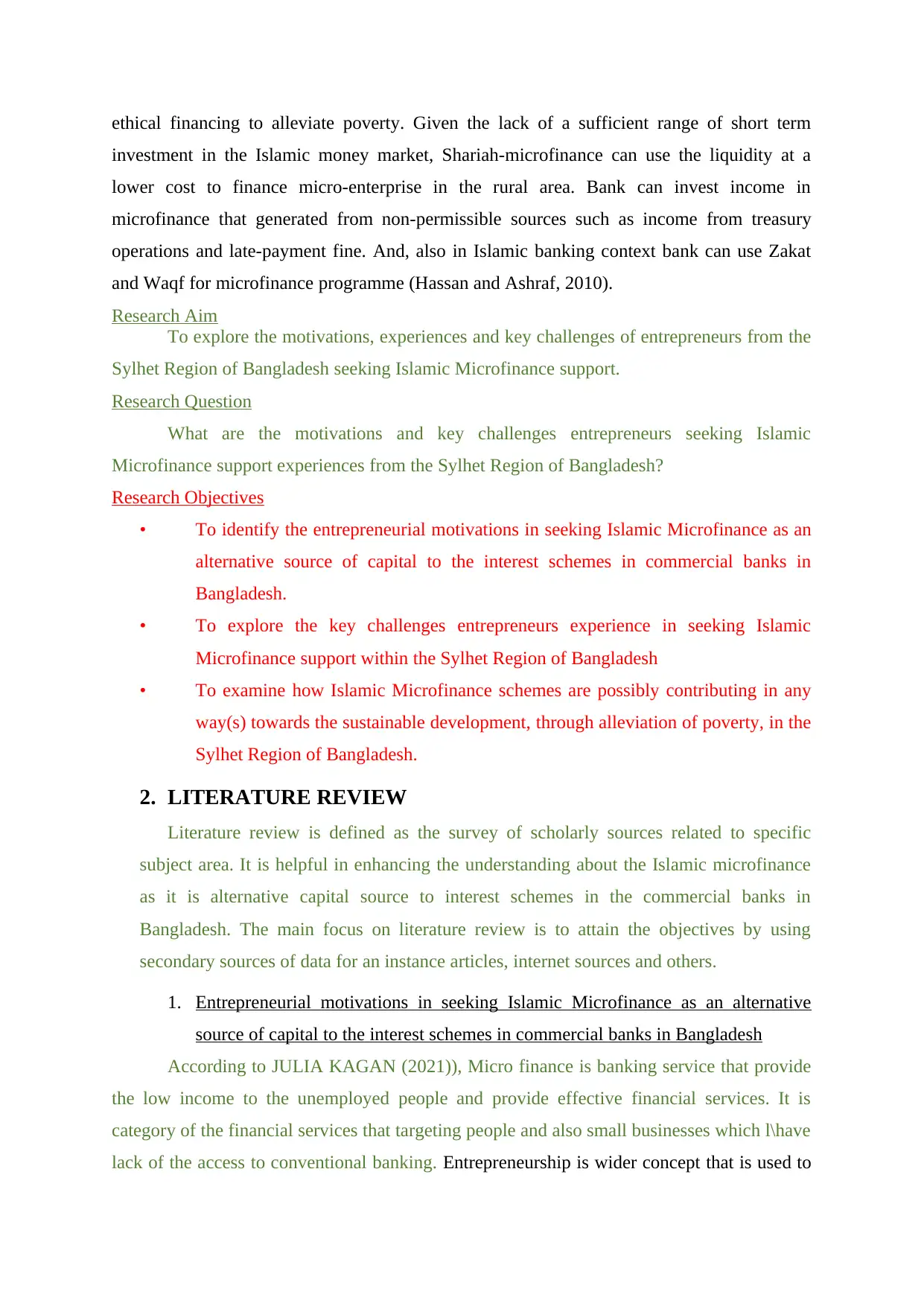
ethical financing to alleviate poverty. Given the lack of a sufficient range of short term
investment in the Islamic money market, Shariah-microfinance can use the liquidity at a
lower cost to finance micro-enterprise in the rural area. Bank can invest income in
microfinance that generated from non-permissible sources such as income from treasury
operations and late-payment fine. And, also in Islamic banking context bank can use Zakat
and Waqf for microfinance programme (Hassan and Ashraf, 2010).
Research Aim
To explore the motivations, experiences and key challenges of entrepreneurs from the
Sylhet Region of Bangladesh seeking Islamic Microfinance support.
Research Question
What are the motivations and key challenges entrepreneurs seeking Islamic
Microfinance support experiences from the Sylhet Region of Bangladesh?
Research Objectives
• To identify the entrepreneurial motivations in seeking Islamic Microfinance as an
alternative source of capital to the interest schemes in commercial banks in
Bangladesh.
• To explore the key challenges entrepreneurs experience in seeking Islamic
Microfinance support within the Sylhet Region of Bangladesh
• To examine how Islamic Microfinance schemes are possibly contributing in any
way(s) towards the sustainable development, through alleviation of poverty, in the
Sylhet Region of Bangladesh.
2. LITERATURE REVIEW
Literature review is defined as the survey of scholarly sources related to specific
subject area. It is helpful in enhancing the understanding about the Islamic microfinance
as it is alternative capital source to interest schemes in the commercial banks in
Bangladesh. The main focus on literature review is to attain the objectives by using
secondary sources of data for an instance articles, internet sources and others.
1. Entrepreneurial motivations in seeking Islamic Microfinance as an alternative
source of capital to the interest schemes in commercial banks in Bangladesh
According to JULIA KAGAN (2021)), Micro finance is banking service that provide
the low income to the unemployed people and provide effective financial services. It is
category of the financial services that targeting people and also small businesses which l\have
lack of the access to conventional banking. Entrepreneurship is wider concept that is used to
investment in the Islamic money market, Shariah-microfinance can use the liquidity at a
lower cost to finance micro-enterprise in the rural area. Bank can invest income in
microfinance that generated from non-permissible sources such as income from treasury
operations and late-payment fine. And, also in Islamic banking context bank can use Zakat
and Waqf for microfinance programme (Hassan and Ashraf, 2010).
Research Aim
To explore the motivations, experiences and key challenges of entrepreneurs from the
Sylhet Region of Bangladesh seeking Islamic Microfinance support.
Research Question
What are the motivations and key challenges entrepreneurs seeking Islamic
Microfinance support experiences from the Sylhet Region of Bangladesh?
Research Objectives
• To identify the entrepreneurial motivations in seeking Islamic Microfinance as an
alternative source of capital to the interest schemes in commercial banks in
Bangladesh.
• To explore the key challenges entrepreneurs experience in seeking Islamic
Microfinance support within the Sylhet Region of Bangladesh
• To examine how Islamic Microfinance schemes are possibly contributing in any
way(s) towards the sustainable development, through alleviation of poverty, in the
Sylhet Region of Bangladesh.
2. LITERATURE REVIEW
Literature review is defined as the survey of scholarly sources related to specific
subject area. It is helpful in enhancing the understanding about the Islamic microfinance
as it is alternative capital source to interest schemes in the commercial banks in
Bangladesh. The main focus on literature review is to attain the objectives by using
secondary sources of data for an instance articles, internet sources and others.
1. Entrepreneurial motivations in seeking Islamic Microfinance as an alternative
source of capital to the interest schemes in commercial banks in Bangladesh
According to JULIA KAGAN (2021)), Micro finance is banking service that provide
the low income to the unemployed people and provide effective financial services. It is
category of the financial services that targeting people and also small businesses which l\have
lack of the access to conventional banking. Entrepreneurship is wider concept that is used to
Paraphrase This Document
Need a fresh take? Get an instant paraphrase of this document with our AI Paraphraser
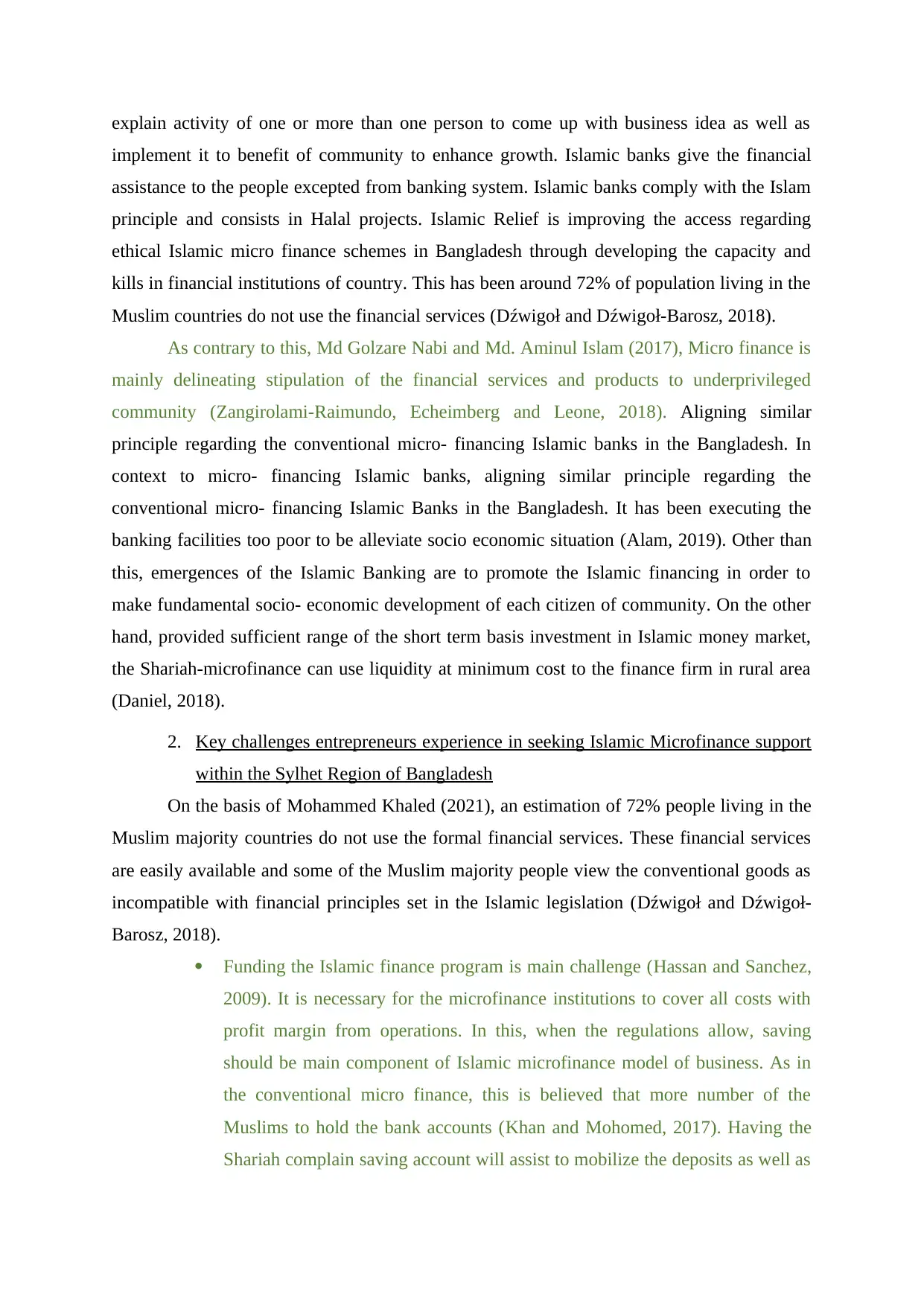
explain activity of one or more than one person to come up with business idea as well as
implement it to benefit of community to enhance growth. Islamic banks give the financial
assistance to the people excepted from banking system. Islamic banks comply with the Islam
principle and consists in Halal projects. Islamic Relief is improving the access regarding
ethical Islamic micro finance schemes in Bangladesh through developing the capacity and
kills in financial institutions of country. This has been around 72% of population living in the
Muslim countries do not use the financial services (Dźwigoł and Dźwigoł-Barosz, 2018).
As contrary to this, Md Golzare Nabi and Md. Aminul Islam (2017), Micro finance is
mainly delineating stipulation of the financial services and products to underprivileged
community (Zangirolami-Raimundo, Echeimberg and Leone, 2018). Aligning similar
principle regarding the conventional micro- financing Islamic banks in the Bangladesh. In
context to micro- financing Islamic banks, aligning similar principle regarding the
conventional micro- financing Islamic Banks in the Bangladesh. It has been executing the
banking facilities too poor to be alleviate socio economic situation (Alam, 2019). Other than
this, emergences of the Islamic Banking are to promote the Islamic financing in order to
make fundamental socio- economic development of each citizen of community. On the other
hand, provided sufficient range of the short term basis investment in Islamic money market,
the Shariah-microfinance can use liquidity at minimum cost to the finance firm in rural area
(Daniel, 2018).
2. Key challenges entrepreneurs experience in seeking Islamic Microfinance support
within the Sylhet Region of Bangladesh
On the basis of Mohammed Khaled (2021), an estimation of 72% people living in the
Muslim majority countries do not use the formal financial services. These financial services
are easily available and some of the Muslim majority people view the conventional goods as
incompatible with financial principles set in the Islamic legislation (Dźwigoł and Dźwigoł-
Barosz, 2018).
Funding the Islamic finance program is main challenge (Hassan and Sanchez,
2009). It is necessary for the microfinance institutions to cover all costs with
profit margin from operations. In this, when the regulations allow, saving
should be main component of Islamic microfinance model of business. As in
the conventional micro finance, this is believed that more number of the
Muslims to hold the bank accounts (Khan and Mohomed, 2017). Having the
Shariah complain saving account will assist to mobilize the deposits as well as
implement it to benefit of community to enhance growth. Islamic banks give the financial
assistance to the people excepted from banking system. Islamic banks comply with the Islam
principle and consists in Halal projects. Islamic Relief is improving the access regarding
ethical Islamic micro finance schemes in Bangladesh through developing the capacity and
kills in financial institutions of country. This has been around 72% of population living in the
Muslim countries do not use the financial services (Dźwigoł and Dźwigoł-Barosz, 2018).
As contrary to this, Md Golzare Nabi and Md. Aminul Islam (2017), Micro finance is
mainly delineating stipulation of the financial services and products to underprivileged
community (Zangirolami-Raimundo, Echeimberg and Leone, 2018). Aligning similar
principle regarding the conventional micro- financing Islamic banks in the Bangladesh. In
context to micro- financing Islamic banks, aligning similar principle regarding the
conventional micro- financing Islamic Banks in the Bangladesh. It has been executing the
banking facilities too poor to be alleviate socio economic situation (Alam, 2019). Other than
this, emergences of the Islamic Banking are to promote the Islamic financing in order to
make fundamental socio- economic development of each citizen of community. On the other
hand, provided sufficient range of the short term basis investment in Islamic money market,
the Shariah-microfinance can use liquidity at minimum cost to the finance firm in rural area
(Daniel, 2018).
2. Key challenges entrepreneurs experience in seeking Islamic Microfinance support
within the Sylhet Region of Bangladesh
On the basis of Mohammed Khaled (2021), an estimation of 72% people living in the
Muslim majority countries do not use the formal financial services. These financial services
are easily available and some of the Muslim majority people view the conventional goods as
incompatible with financial principles set in the Islamic legislation (Dźwigoł and Dźwigoł-
Barosz, 2018).
Funding the Islamic finance program is main challenge (Hassan and Sanchez,
2009). It is necessary for the microfinance institutions to cover all costs with
profit margin from operations. In this, when the regulations allow, saving
should be main component of Islamic microfinance model of business. As in
the conventional micro finance, this is believed that more number of the
Muslims to hold the bank accounts (Khan and Mohomed, 2017). Having the
Shariah complain saving account will assist to mobilize the deposits as well as
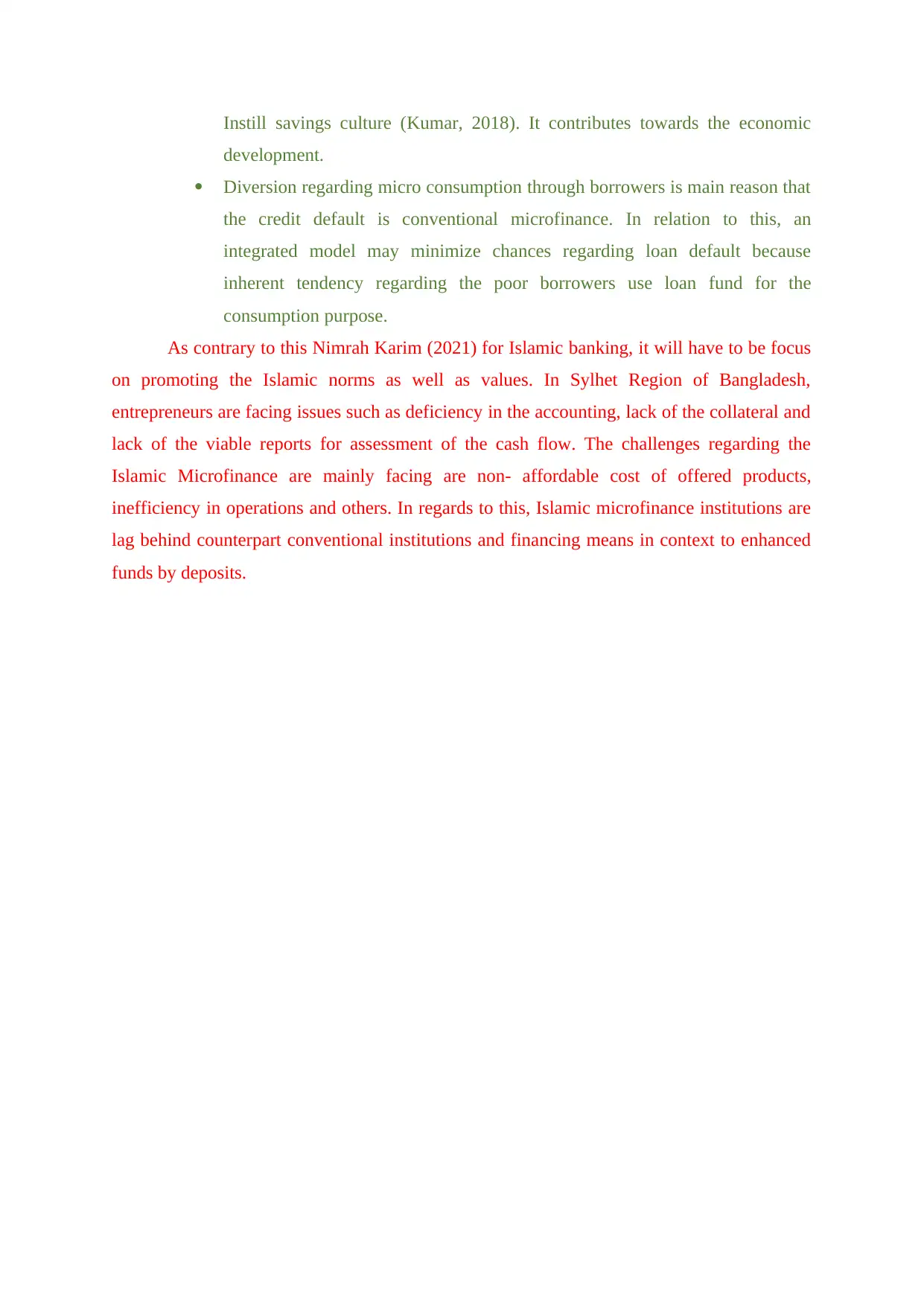
Instill savings culture (Kumar, 2018). It contributes towards the economic
development.
Diversion regarding micro consumption through borrowers is main reason that
the credit default is conventional microfinance. In relation to this, an
integrated model may minimize chances regarding loan default because
inherent tendency regarding the poor borrowers use loan fund for the
consumption purpose.
As contrary to this Nimrah Karim (2021) for Islamic banking, it will have to be focus
on promoting the Islamic norms as well as values. In Sylhet Region of Bangladesh,
entrepreneurs are facing issues such as deficiency in the accounting, lack of the collateral and
lack of the viable reports for assessment of the cash flow. The challenges regarding the
Islamic Microfinance are mainly facing are non- affordable cost of offered products,
inefficiency in operations and others. In regards to this, Islamic microfinance institutions are
lag behind counterpart conventional institutions and financing means in context to enhanced
funds by deposits.
development.
Diversion regarding micro consumption through borrowers is main reason that
the credit default is conventional microfinance. In relation to this, an
integrated model may minimize chances regarding loan default because
inherent tendency regarding the poor borrowers use loan fund for the
consumption purpose.
As contrary to this Nimrah Karim (2021) for Islamic banking, it will have to be focus
on promoting the Islamic norms as well as values. In Sylhet Region of Bangladesh,
entrepreneurs are facing issues such as deficiency in the accounting, lack of the collateral and
lack of the viable reports for assessment of the cash flow. The challenges regarding the
Islamic Microfinance are mainly facing are non- affordable cost of offered products,
inefficiency in operations and others. In regards to this, Islamic microfinance institutions are
lag behind counterpart conventional institutions and financing means in context to enhanced
funds by deposits.
⊘ This is a preview!⊘
Do you want full access?
Subscribe today to unlock all pages.

Trusted by 1+ million students worldwide
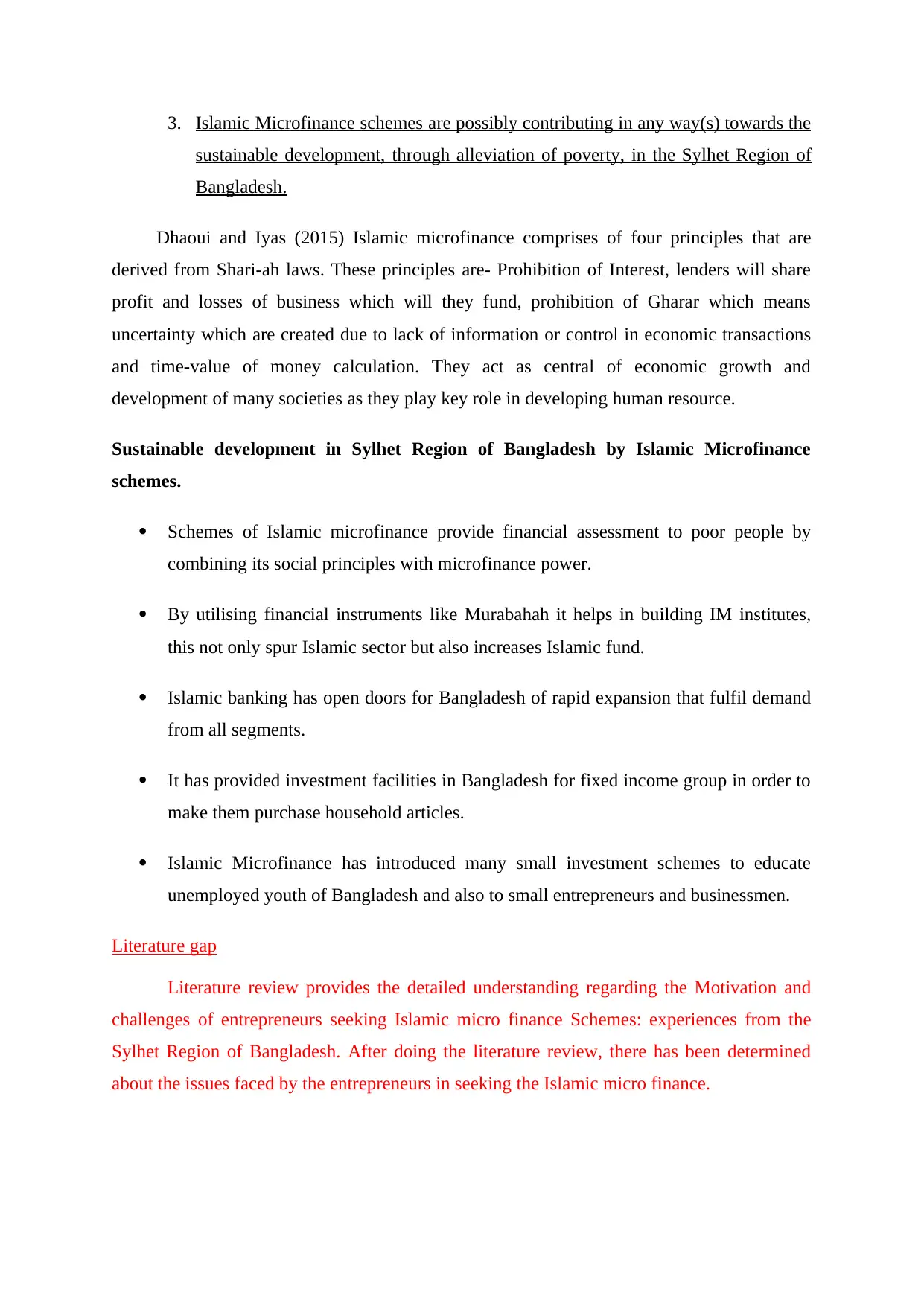
3. Islamic Microfinance schemes are possibly contributing in any way(s) towards the
sustainable development, through alleviation of poverty, in the Sylhet Region of
Bangladesh.
Dhaoui and Iyas (2015) Islamic microfinance comprises of four principles that are
derived from Shari-ah laws. These principles are- Prohibition of Interest, lenders will share
profit and losses of business which will they fund, prohibition of Gharar which means
uncertainty which are created due to lack of information or control in economic transactions
and time-value of money calculation. They act as central of economic growth and
development of many societies as they play key role in developing human resource.
Sustainable development in Sylhet Region of Bangladesh by Islamic Microfinance
schemes.
Schemes of Islamic microfinance provide financial assessment to poor people by
combining its social principles with microfinance power.
By utilising financial instruments like Murabahah it helps in building IM institutes,
this not only spur Islamic sector but also increases Islamic fund.
Islamic banking has open doors for Bangladesh of rapid expansion that fulfil demand
from all segments.
It has provided investment facilities in Bangladesh for fixed income group in order to
make them purchase household articles.
Islamic Microfinance has introduced many small investment schemes to educate
unemployed youth of Bangladesh and also to small entrepreneurs and businessmen.
Literature gap
Literature review provides the detailed understanding regarding the Motivation and
challenges of entrepreneurs seeking Islamic micro finance Schemes: experiences from the
Sylhet Region of Bangladesh. After doing the literature review, there has been determined
about the issues faced by the entrepreneurs in seeking the Islamic micro finance.
sustainable development, through alleviation of poverty, in the Sylhet Region of
Bangladesh.
Dhaoui and Iyas (2015) Islamic microfinance comprises of four principles that are
derived from Shari-ah laws. These principles are- Prohibition of Interest, lenders will share
profit and losses of business which will they fund, prohibition of Gharar which means
uncertainty which are created due to lack of information or control in economic transactions
and time-value of money calculation. They act as central of economic growth and
development of many societies as they play key role in developing human resource.
Sustainable development in Sylhet Region of Bangladesh by Islamic Microfinance
schemes.
Schemes of Islamic microfinance provide financial assessment to poor people by
combining its social principles with microfinance power.
By utilising financial instruments like Murabahah it helps in building IM institutes,
this not only spur Islamic sector but also increases Islamic fund.
Islamic banking has open doors for Bangladesh of rapid expansion that fulfil demand
from all segments.
It has provided investment facilities in Bangladesh for fixed income group in order to
make them purchase household articles.
Islamic Microfinance has introduced many small investment schemes to educate
unemployed youth of Bangladesh and also to small entrepreneurs and businessmen.
Literature gap
Literature review provides the detailed understanding regarding the Motivation and
challenges of entrepreneurs seeking Islamic micro finance Schemes: experiences from the
Sylhet Region of Bangladesh. After doing the literature review, there has been determined
about the issues faced by the entrepreneurs in seeking the Islamic micro finance.
Paraphrase This Document
Need a fresh take? Get an instant paraphrase of this document with our AI Paraphraser
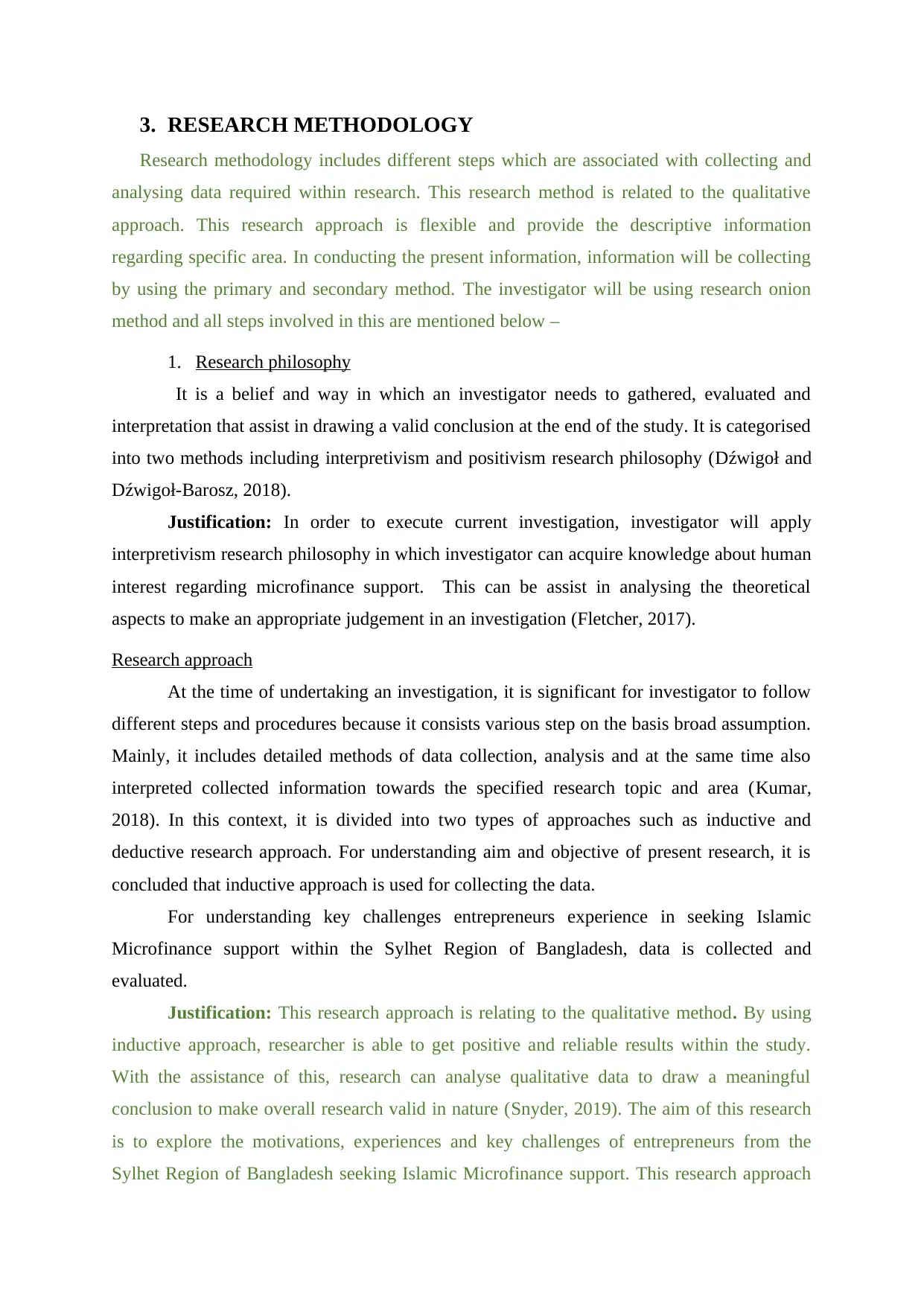
3. RESEARCH METHODOLOGY
Research methodology includes different steps which are associated with collecting and
analysing data required within research. This research method is related to the qualitative
approach. This research approach is flexible and provide the descriptive information
regarding specific area. In conducting the present information, information will be collecting
by using the primary and secondary method. The investigator will be using research onion
method and all steps involved in this are mentioned below –
1. Research philosophy
It is a belief and way in which an investigator needs to gathered, evaluated and
interpretation that assist in drawing a valid conclusion at the end of the study. It is categorised
into two methods including interpretivism and positivism research philosophy (Dźwigoł and
Dźwigoł-Barosz, 2018).
Justification: In order to execute current investigation, investigator will apply
interpretivism research philosophy in which investigator can acquire knowledge about human
interest regarding microfinance support. This can be assist in analysing the theoretical
aspects to make an appropriate judgement in an investigation (Fletcher, 2017).
Research approach
At the time of undertaking an investigation, it is significant for investigator to follow
different steps and procedures because it consists various step on the basis broad assumption.
Mainly, it includes detailed methods of data collection, analysis and at the same time also
interpreted collected information towards the specified research topic and area (Kumar,
2018). In this context, it is divided into two types of approaches such as inductive and
deductive research approach. For understanding aim and objective of present research, it is
concluded that inductive approach is used for collecting the data.
For understanding key challenges entrepreneurs experience in seeking Islamic
Microfinance support within the Sylhet Region of Bangladesh, data is collected and
evaluated.
Justification: This research approach is relating to the qualitative method. By using
inductive approach, researcher is able to get positive and reliable results within the study.
With the assistance of this, research can analyse qualitative data to draw a meaningful
conclusion to make overall research valid in nature (Snyder, 2019). The aim of this research
is to explore the motivations, experiences and key challenges of entrepreneurs from the
Sylhet Region of Bangladesh seeking Islamic Microfinance support. This research approach
Research methodology includes different steps which are associated with collecting and
analysing data required within research. This research method is related to the qualitative
approach. This research approach is flexible and provide the descriptive information
regarding specific area. In conducting the present information, information will be collecting
by using the primary and secondary method. The investigator will be using research onion
method and all steps involved in this are mentioned below –
1. Research philosophy
It is a belief and way in which an investigator needs to gathered, evaluated and
interpretation that assist in drawing a valid conclusion at the end of the study. It is categorised
into two methods including interpretivism and positivism research philosophy (Dźwigoł and
Dźwigoł-Barosz, 2018).
Justification: In order to execute current investigation, investigator will apply
interpretivism research philosophy in which investigator can acquire knowledge about human
interest regarding microfinance support. This can be assist in analysing the theoretical
aspects to make an appropriate judgement in an investigation (Fletcher, 2017).
Research approach
At the time of undertaking an investigation, it is significant for investigator to follow
different steps and procedures because it consists various step on the basis broad assumption.
Mainly, it includes detailed methods of data collection, analysis and at the same time also
interpreted collected information towards the specified research topic and area (Kumar,
2018). In this context, it is divided into two types of approaches such as inductive and
deductive research approach. For understanding aim and objective of present research, it is
concluded that inductive approach is used for collecting the data.
For understanding key challenges entrepreneurs experience in seeking Islamic
Microfinance support within the Sylhet Region of Bangladesh, data is collected and
evaluated.
Justification: This research approach is relating to the qualitative method. By using
inductive approach, researcher is able to get positive and reliable results within the study.
With the assistance of this, research can analyse qualitative data to draw a meaningful
conclusion to make overall research valid in nature (Snyder, 2019). The aim of this research
is to explore the motivations, experiences and key challenges of entrepreneurs from the
Sylhet Region of Bangladesh seeking Islamic Microfinance support. This research approach
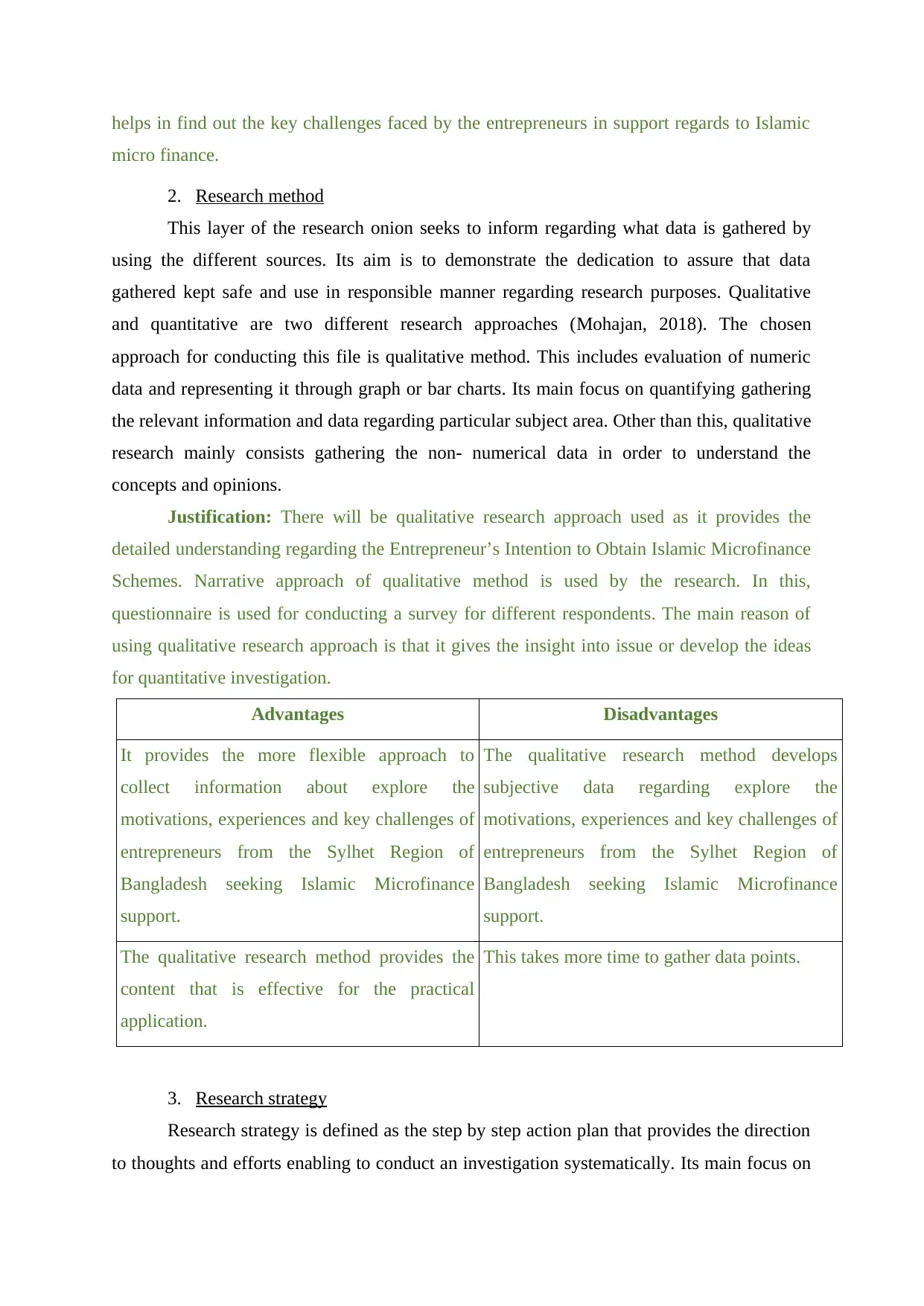
helps in find out the key challenges faced by the entrepreneurs in support regards to Islamic
micro finance.
2. Research method
This layer of the research onion seeks to inform regarding what data is gathered by
using the different sources. Its aim is to demonstrate the dedication to assure that data
gathered kept safe and use in responsible manner regarding research purposes. Qualitative
and quantitative are two different research approaches (Mohajan, 2018). The chosen
approach for conducting this file is qualitative method. This includes evaluation of numeric
data and representing it through graph or bar charts. Its main focus on quantifying gathering
the relevant information and data regarding particular subject area. Other than this, qualitative
research mainly consists gathering the non- numerical data in order to understand the
concepts and opinions.
Justification: There will be qualitative research approach used as it provides the
detailed understanding regarding the Entrepreneur’s Intention to Obtain Islamic Microfinance
Schemes. Narrative approach of qualitative method is used by the research. In this,
questionnaire is used for conducting a survey for different respondents. The main reason of
using qualitative research approach is that it gives the insight into issue or develop the ideas
for quantitative investigation.
Advantages Disadvantages
It provides the more flexible approach to
collect information about explore the
motivations, experiences and key challenges of
entrepreneurs from the Sylhet Region of
Bangladesh seeking Islamic Microfinance
support.
The qualitative research method develops
subjective data regarding explore the
motivations, experiences and key challenges of
entrepreneurs from the Sylhet Region of
Bangladesh seeking Islamic Microfinance
support.
The qualitative research method provides the
content that is effective for the practical
application.
This takes more time to gather data points.
3. Research strategy
Research strategy is defined as the step by step action plan that provides the direction
to thoughts and efforts enabling to conduct an investigation systematically. Its main focus on
micro finance.
2. Research method
This layer of the research onion seeks to inform regarding what data is gathered by
using the different sources. Its aim is to demonstrate the dedication to assure that data
gathered kept safe and use in responsible manner regarding research purposes. Qualitative
and quantitative are two different research approaches (Mohajan, 2018). The chosen
approach for conducting this file is qualitative method. This includes evaluation of numeric
data and representing it through graph or bar charts. Its main focus on quantifying gathering
the relevant information and data regarding particular subject area. Other than this, qualitative
research mainly consists gathering the non- numerical data in order to understand the
concepts and opinions.
Justification: There will be qualitative research approach used as it provides the
detailed understanding regarding the Entrepreneur’s Intention to Obtain Islamic Microfinance
Schemes. Narrative approach of qualitative method is used by the research. In this,
questionnaire is used for conducting a survey for different respondents. The main reason of
using qualitative research approach is that it gives the insight into issue or develop the ideas
for quantitative investigation.
Advantages Disadvantages
It provides the more flexible approach to
collect information about explore the
motivations, experiences and key challenges of
entrepreneurs from the Sylhet Region of
Bangladesh seeking Islamic Microfinance
support.
The qualitative research method develops
subjective data regarding explore the
motivations, experiences and key challenges of
entrepreneurs from the Sylhet Region of
Bangladesh seeking Islamic Microfinance
support.
The qualitative research method provides the
content that is effective for the practical
application.
This takes more time to gather data points.
3. Research strategy
Research strategy is defined as the step by step action plan that provides the direction
to thoughts and efforts enabling to conduct an investigation systematically. Its main focus on
⊘ This is a preview!⊘
Do you want full access?
Subscribe today to unlock all pages.

Trusted by 1+ million students worldwide
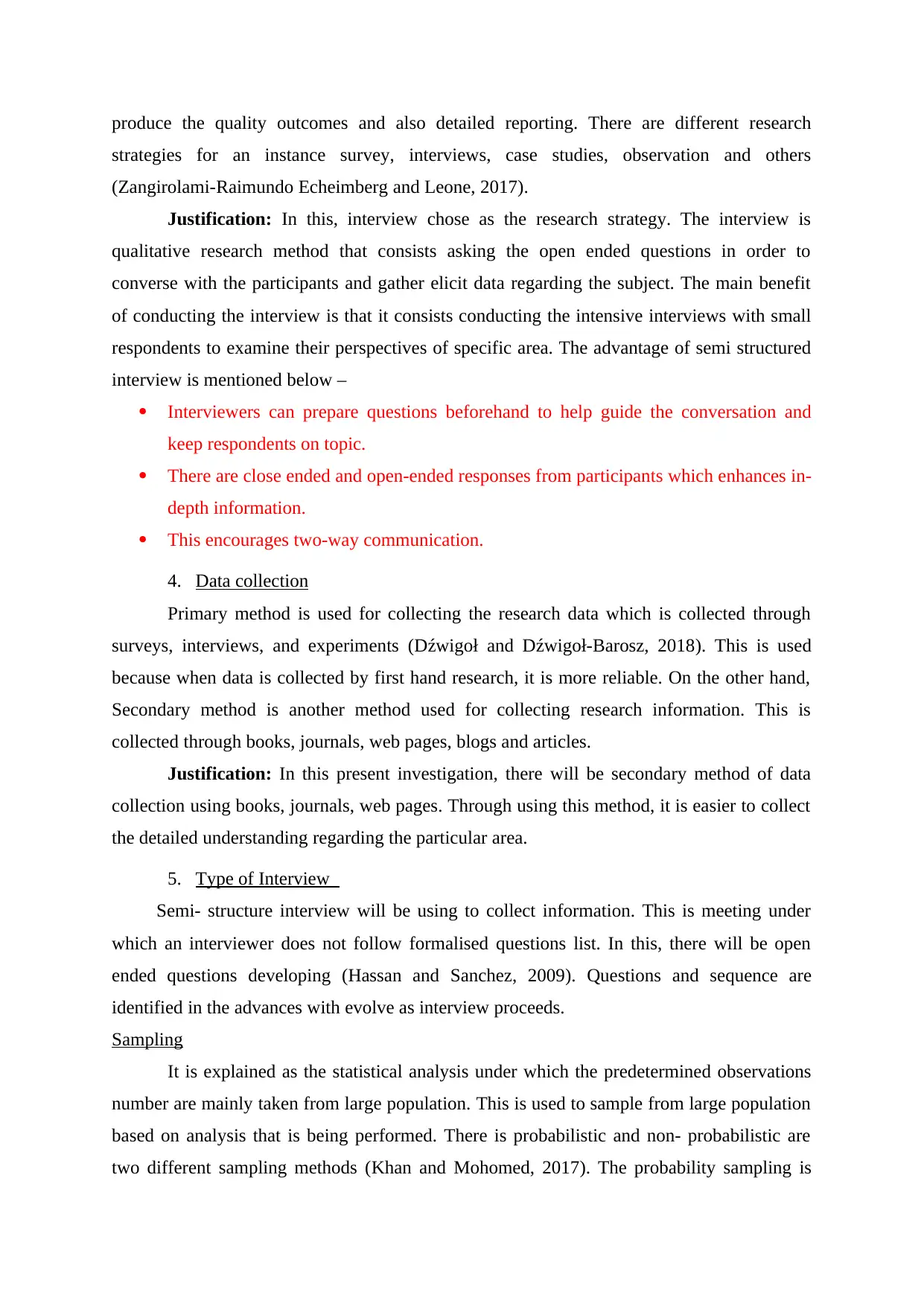
produce the quality outcomes and also detailed reporting. There are different research
strategies for an instance survey, interviews, case studies, observation and others
(Zangirolami-Raimundo Echeimberg and Leone, 2017).
Justification: In this, interview chose as the research strategy. The interview is
qualitative research method that consists asking the open ended questions in order to
converse with the participants and gather elicit data regarding the subject. The main benefit
of conducting the interview is that it consists conducting the intensive interviews with small
respondents to examine their perspectives of specific area. The advantage of semi structured
interview is mentioned below –
Interviewers can prepare questions beforehand to help guide the conversation and
keep respondents on topic.
There are close ended and open-ended responses from participants which enhances in-
depth information.
This encourages two-way communication.
4. Data collection
Primary method is used for collecting the research data which is collected through
surveys, interviews, and experiments (Dźwigoł and Dźwigoł-Barosz, 2018). This is used
because when data is collected by first hand research, it is more reliable. On the other hand,
Secondary method is another method used for collecting research information. This is
collected through books, journals, web pages, blogs and articles.
Justification: In this present investigation, there will be secondary method of data
collection using books, journals, web pages. Through using this method, it is easier to collect
the detailed understanding regarding the particular area.
5. Type of Interview
Semi- structure interview will be using to collect information. This is meeting under
which an interviewer does not follow formalised questions list. In this, there will be open
ended questions developing (Hassan and Sanchez, 2009). Questions and sequence are
identified in the advances with evolve as interview proceeds.
Sampling
It is explained as the statistical analysis under which the predetermined observations
number are mainly taken from large population. This is used to sample from large population
based on analysis that is being performed. There is probabilistic and non- probabilistic are
two different sampling methods (Khan and Mohomed, 2017). The probability sampling is
strategies for an instance survey, interviews, case studies, observation and others
(Zangirolami-Raimundo Echeimberg and Leone, 2017).
Justification: In this, interview chose as the research strategy. The interview is
qualitative research method that consists asking the open ended questions in order to
converse with the participants and gather elicit data regarding the subject. The main benefit
of conducting the interview is that it consists conducting the intensive interviews with small
respondents to examine their perspectives of specific area. The advantage of semi structured
interview is mentioned below –
Interviewers can prepare questions beforehand to help guide the conversation and
keep respondents on topic.
There are close ended and open-ended responses from participants which enhances in-
depth information.
This encourages two-way communication.
4. Data collection
Primary method is used for collecting the research data which is collected through
surveys, interviews, and experiments (Dźwigoł and Dźwigoł-Barosz, 2018). This is used
because when data is collected by first hand research, it is more reliable. On the other hand,
Secondary method is another method used for collecting research information. This is
collected through books, journals, web pages, blogs and articles.
Justification: In this present investigation, there will be secondary method of data
collection using books, journals, web pages. Through using this method, it is easier to collect
the detailed understanding regarding the particular area.
5. Type of Interview
Semi- structure interview will be using to collect information. This is meeting under
which an interviewer does not follow formalised questions list. In this, there will be open
ended questions developing (Hassan and Sanchez, 2009). Questions and sequence are
identified in the advances with evolve as interview proceeds.
Sampling
It is explained as the statistical analysis under which the predetermined observations
number are mainly taken from large population. This is used to sample from large population
based on analysis that is being performed. There is probabilistic and non- probabilistic are
two different sampling methods (Khan and Mohomed, 2017). The probability sampling is
Paraphrase This Document
Need a fresh take? Get an instant paraphrase of this document with our AI Paraphraser
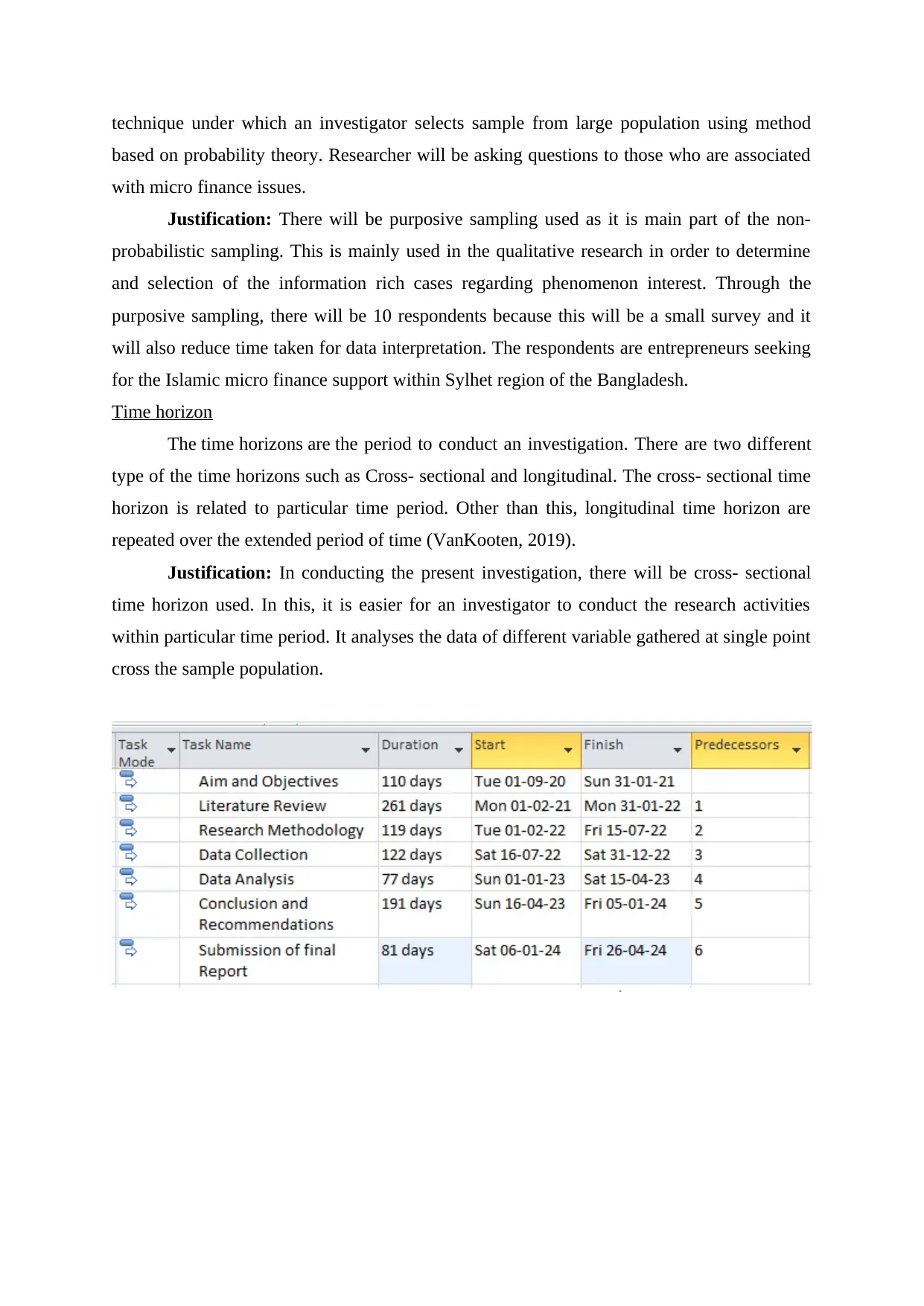
technique under which an investigator selects sample from large population using method
based on probability theory. Researcher will be asking questions to those who are associated
with micro finance issues.
Justification: There will be purposive sampling used as it is main part of the non-
probabilistic sampling. This is mainly used in the qualitative research in order to determine
and selection of the information rich cases regarding phenomenon interest. Through the
purposive sampling, there will be 10 respondents because this will be a small survey and it
will also reduce time taken for data interpretation. The respondents are entrepreneurs seeking
for the Islamic micro finance support within Sylhet region of the Bangladesh.
Time horizon
The time horizons are the period to conduct an investigation. There are two different
type of the time horizons such as Cross- sectional and longitudinal. The cross- sectional time
horizon is related to particular time period. Other than this, longitudinal time horizon are
repeated over the extended period of time (VanKooten, 2019).
Justification: In conducting the present investigation, there will be cross- sectional
time horizon used. In this, it is easier for an investigator to conduct the research activities
within particular time period. It analyses the data of different variable gathered at single point
cross the sample population.
based on probability theory. Researcher will be asking questions to those who are associated
with micro finance issues.
Justification: There will be purposive sampling used as it is main part of the non-
probabilistic sampling. This is mainly used in the qualitative research in order to determine
and selection of the information rich cases regarding phenomenon interest. Through the
purposive sampling, there will be 10 respondents because this will be a small survey and it
will also reduce time taken for data interpretation. The respondents are entrepreneurs seeking
for the Islamic micro finance support within Sylhet region of the Bangladesh.
Time horizon
The time horizons are the period to conduct an investigation. There are two different
type of the time horizons such as Cross- sectional and longitudinal. The cross- sectional time
horizon is related to particular time period. Other than this, longitudinal time horizon are
repeated over the extended period of time (VanKooten, 2019).
Justification: In conducting the present investigation, there will be cross- sectional
time horizon used. In this, it is easier for an investigator to conduct the research activities
within particular time period. It analyses the data of different variable gathered at single point
cross the sample population.
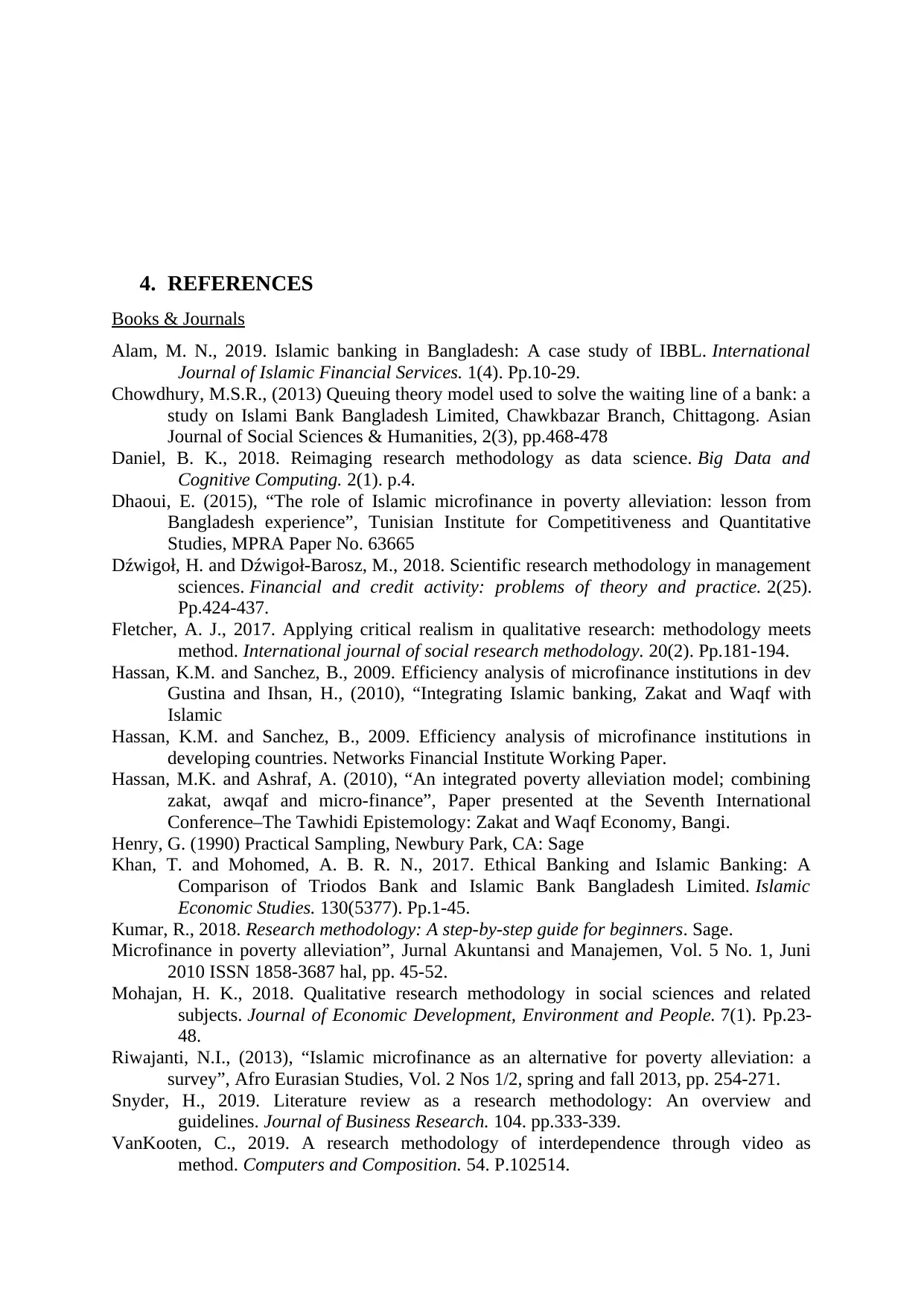
4. REFERENCES
Books & Journals
Alam, M. N., 2019. Islamic banking in Bangladesh: A case study of IBBL. International
Journal of Islamic Financial Services. 1(4). Pp.10-29.
Chowdhury, M.S.R., (2013) Queuing theory model used to solve the waiting line of a bank: a
study on Islami Bank Bangladesh Limited, Chawkbazar Branch, Chittagong. Asian
Journal of Social Sciences & Humanities, 2(3), pp.468-478
Daniel, B. K., 2018. Reimaging research methodology as data science. Big Data and
Cognitive Computing. 2(1). p.4.
Dhaoui, E. (2015), “The role of Islamic microfinance in poverty alleviation: lesson from
Bangladesh experience”, Tunisian Institute for Competitiveness and Quantitative
Studies, MPRA Paper No. 63665
Dźwigoł, H. and Dźwigoł-Barosz, M., 2018. Scientific research methodology in management
sciences. Financial and credit activity: problems of theory and practice. 2(25).
Pp.424-437.
Fletcher, A. J., 2017. Applying critical realism in qualitative research: methodology meets
method. International journal of social research methodology. 20(2). Pp.181-194.
Hassan, K.M. and Sanchez, B., 2009. Efficiency analysis of microfinance institutions in dev
Gustina and Ihsan, H., (2010), “Integrating Islamic banking, Zakat and Waqf with
Islamic
Hassan, K.M. and Sanchez, B., 2009. Efficiency analysis of microfinance institutions in
developing countries. Networks Financial Institute Working Paper.
Hassan, M.K. and Ashraf, A. (2010), “An integrated poverty alleviation model; combining
zakat, awqaf and micro-finance”, Paper presented at the Seventh International
Conference–The Tawhidi Epistemology: Zakat and Waqf Economy, Bangi.
Henry, G. (1990) Practical Sampling, Newbury Park, CA: Sage
Khan, T. and Mohomed, A. B. R. N., 2017. Ethical Banking and Islamic Banking: A
Comparison of Triodos Bank and Islamic Bank Bangladesh Limited. Islamic
Economic Studies. 130(5377). Pp.1-45.
Kumar, R., 2018. Research methodology: A step-by-step guide for beginners. Sage.
Microfinance in poverty alleviation”, Jurnal Akuntansi and Manajemen, Vol. 5 No. 1, Juni
2010 ISSN 1858-3687 hal, pp. 45-52.
Mohajan, H. K., 2018. Qualitative research methodology in social sciences and related
subjects. Journal of Economic Development, Environment and People. 7(1). Pp.23-
48.
Riwajanti, N.I., (2013), “Islamic microfinance as an alternative for poverty alleviation: a
survey”, Afro Eurasian Studies, Vol. 2 Nos 1/2, spring and fall 2013, pp. 254-271.
Snyder, H., 2019. Literature review as a research methodology: An overview and
guidelines. Journal of Business Research. 104. pp.333-339.
VanKooten, C., 2019. A research methodology of interdependence through video as
method. Computers and Composition. 54. P.102514.
Books & Journals
Alam, M. N., 2019. Islamic banking in Bangladesh: A case study of IBBL. International
Journal of Islamic Financial Services. 1(4). Pp.10-29.
Chowdhury, M.S.R., (2013) Queuing theory model used to solve the waiting line of a bank: a
study on Islami Bank Bangladesh Limited, Chawkbazar Branch, Chittagong. Asian
Journal of Social Sciences & Humanities, 2(3), pp.468-478
Daniel, B. K., 2018. Reimaging research methodology as data science. Big Data and
Cognitive Computing. 2(1). p.4.
Dhaoui, E. (2015), “The role of Islamic microfinance in poverty alleviation: lesson from
Bangladesh experience”, Tunisian Institute for Competitiveness and Quantitative
Studies, MPRA Paper No. 63665
Dźwigoł, H. and Dźwigoł-Barosz, M., 2018. Scientific research methodology in management
sciences. Financial and credit activity: problems of theory and practice. 2(25).
Pp.424-437.
Fletcher, A. J., 2017. Applying critical realism in qualitative research: methodology meets
method. International journal of social research methodology. 20(2). Pp.181-194.
Hassan, K.M. and Sanchez, B., 2009. Efficiency analysis of microfinance institutions in dev
Gustina and Ihsan, H., (2010), “Integrating Islamic banking, Zakat and Waqf with
Islamic
Hassan, K.M. and Sanchez, B., 2009. Efficiency analysis of microfinance institutions in
developing countries. Networks Financial Institute Working Paper.
Hassan, M.K. and Ashraf, A. (2010), “An integrated poverty alleviation model; combining
zakat, awqaf and micro-finance”, Paper presented at the Seventh International
Conference–The Tawhidi Epistemology: Zakat and Waqf Economy, Bangi.
Henry, G. (1990) Practical Sampling, Newbury Park, CA: Sage
Khan, T. and Mohomed, A. B. R. N., 2017. Ethical Banking and Islamic Banking: A
Comparison of Triodos Bank and Islamic Bank Bangladesh Limited. Islamic
Economic Studies. 130(5377). Pp.1-45.
Kumar, R., 2018. Research methodology: A step-by-step guide for beginners. Sage.
Microfinance in poverty alleviation”, Jurnal Akuntansi and Manajemen, Vol. 5 No. 1, Juni
2010 ISSN 1858-3687 hal, pp. 45-52.
Mohajan, H. K., 2018. Qualitative research methodology in social sciences and related
subjects. Journal of Economic Development, Environment and People. 7(1). Pp.23-
48.
Riwajanti, N.I., (2013), “Islamic microfinance as an alternative for poverty alleviation: a
survey”, Afro Eurasian Studies, Vol. 2 Nos 1/2, spring and fall 2013, pp. 254-271.
Snyder, H., 2019. Literature review as a research methodology: An overview and
guidelines. Journal of Business Research. 104. pp.333-339.
VanKooten, C., 2019. A research methodology of interdependence through video as
method. Computers and Composition. 54. P.102514.
⊘ This is a preview!⊘
Do you want full access?
Subscribe today to unlock all pages.

Trusted by 1+ million students worldwide
1 out of 13
Related Documents
Your All-in-One AI-Powered Toolkit for Academic Success.
+13062052269
info@desklib.com
Available 24*7 on WhatsApp / Email
![[object Object]](/_next/static/media/star-bottom.7253800d.svg)
Unlock your academic potential
Copyright © 2020–2025 A2Z Services. All Rights Reserved. Developed and managed by ZUCOL.



